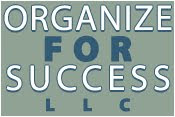
Step One... Determine what needs to be kept for how long. Although a quick Internet search of "record retention" or "what to keep for how long in office" produces a wide variety of websites to help, it is always advised to check with your accountant for current requirements, too. A little bit of homework can go a long way for making the purging and sorting process much easier.
Step Two... Purge what doesn't need to be kept. My clients like using separate bins for TO KEEP, TO RECYCLE, TO SHRED and TO OTHERS when working through the purging process, but the particular categories you use would be unique to your specific needs. As you review each item, determine what's the worst possible result if you get rid of it; then, determine if you can replace it should the need arise.
Step Three... Sort items from the TO KEEP bin into categories. Group like with like into appropriate yet general categories that will aid in correctly labeling contents to remain in your space. You want to have enough files to contain all items that will remain, but you don't want to have too many files. If you have to wonder in which file a document should be added when filing that document, chances are good you'll wonder about the same thing when going to retrieve that document, which goes back to the need for limiting the number of files as available options when originally creating those file folder options.
Step Four... Color-code your system. Color is fantastic, and creating appropriate yet general categories limits the number that you use, allowing you to assign a different color to each category. File folders now come in such fabulous colors, including ones that are lighter inside than out so you know for certain when you are putting papers inside the file rather than in between files in the same drawer. Furthermore, colors drive action: you can see at a glance to which topic the file is related and a topic you dislike in a file that's your favorite color is less likely to be avoided.
Step Five... Assign a "home" to each category's items. Make sure to account for what you already have as well as what will be added. Then, when creating sub-categories, utilize the same tab position. For example, for the TAXES category, you may use the same, far-left tab position for TAXES 2010, TAXES 2009, etc. For the THINGS OWNED category, you may use middle tabbed files for STOCKS, BOAT, AUTOMOBILE, HOUSE, INSURED JEWELS, etc.
The goal is to know where to quickly locate what is needed when you need it... Can you put your hands on any piece of paper in 30 seconds or less when you determine that you need it? What paper management tactics do you use for your file drawers, and what's working best? Do you mirror those tactics for your electronic files? Please share in the Comments below.

No comments:
Post a Comment